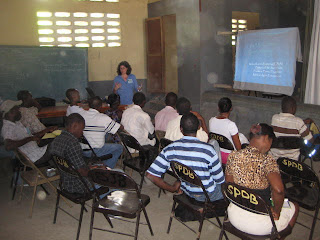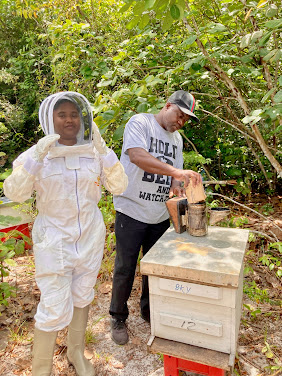Blog from Robert Spencer, Volunteer in Haiti
Writing from Haiti, food safety volunteer Robert Spencer sent us some information and photos from his first week to post on the blog. Below are a few excerpts. It's always interesting to follow the footsteps of a Farmer to Farmer volunteer while they are in country!
This is my third visit; first October 06, second April 08. Spent my first Monday (afternoon of 10th) getting settled into Hotel Prince, and a short amount of time with Papy and Charlie discussing progress made and agenda for upcoming week. Hotel offers beautiful view of the bay, stunning abundance of flowers, truly fascinating accommodations, and very quiet location. This converted hotel was originally the home of Pauline Bonaparte, sister of Napoleon Bonaparte. See photo (View of bay from hotel)
[Next day] Five farm visits that day to review progress being made, rabbitries scattered across surrounding areas of Cap Haitian (CAP). Was truly impressive; rabbits at all facilities in good body condition, cages and areas under them clean and in good shape, rabbits fairly well protected in all cases. A good time was had by all, made sure to communicate qualities found in each facility so farmer would know their efforts were appreciated. See photo (Successful rabbit producers, FTF Field Officer Gerard Michel "Papy" Joseph, and Charlie - driver and collaborator)
[Next day] We visited three rabbitries; reason for less is they were scattered in areas remotely located from CAP. When I asked Benito why some of these locations were scattered, he explained his strategy is based on spreading production facilities to show various communities opportunities in rabbit production. They select key individuals who show interest and initiative, help them begin small and simple which allows them to prove themselves over a period of time. If they prove themselves and become successful they are rewarded with a “state of the art” rabbitry, more cages and rabbits, and expected to pay back the provisions by selling back so many rabbits a month. Based on the producer pride and enthusiasm demonstrated it is working. I was really impressed. See photo (model rabbitry made available for outstanding producer's use)
 [A few days later] Workshop began on time (9 am) at local educational facility; people were there before we arrived, ready to learn about food safety. My first component was designed to be a “wake-up call” to those involved in the food industry from farm to fork. It addressed the need for food safety within Haiti’s food industry, the role it would play, the challenges associated with implementation, and the benefits and economic impact. At first I was concerned there would be no or little interaction, following the information shared. To my surprise there was a lengthy interaction that went on for just short of an hour. Like most Haitian discussions it covered a broad array of issues including meat quality assurance, environmental issues, government support, economics (including supply, demand, value-added, and etc.), marketing, and etc. The interaction was quite impressive. At the end I asked the audience if they agreed with what had been presented, and did they see the role of food safety to the future of Haiti and they readily agreed to its significance and potential impact benefiting Haiti and its people. See photo (Spencer speaking to audience about the role of heat in cooking food thoroughly - meat thermometer in hand)
[A few days later] Workshop began on time (9 am) at local educational facility; people were there before we arrived, ready to learn about food safety. My first component was designed to be a “wake-up call” to those involved in the food industry from farm to fork. It addressed the need for food safety within Haiti’s food industry, the role it would play, the challenges associated with implementation, and the benefits and economic impact. At first I was concerned there would be no or little interaction, following the information shared. To my surprise there was a lengthy interaction that went on for just short of an hour. Like most Haitian discussions it covered a broad array of issues including meat quality assurance, environmental issues, government support, economics (including supply, demand, value-added, and etc.), marketing, and etc. The interaction was quite impressive. At the end I asked the audience if they agreed with what had been presented, and did they see the role of food safety to the future of Haiti and they readily agreed to its significance and potential impact benefiting Haiti and its people. See photo (Spencer speaking to audience about the role of heat in cooking food thoroughly - meat thermometer in hand)
Myriam did an outstanding job of covering five primary zoonotic diseases that should be of concern regarding meat quality and food safety. (see photo) Her approach was outstanding as it addressed each disease, the fundamental factors in each disease, symptoms, treatment, prevention, and other relevant details. At the end she covered general Best Management Practices (BMP) to reduce or minimize risks associated with seven primary zoonotic diseases. She also took the time to address food borne disease and illness. Outstanding job, people were really impressed! My second presentation addressed Hazard Analysis Critical Control Points (HACCP) as a potential program to be implemented that would benefit the Food Industry within Haiti.
During my first week I have been amazed to see the amount of progress that has taken place resulting from the past four years of efforts and support from all involved. Partners of the Americas, Farmer to Farmer, Benito Jasmin, and his associates are to be commended.
This is my third visit; first October 06, second April 08. Spent my first Monday (afternoon of 10th) getting settled into Hotel Prince, and a short amount of time with Papy and Charlie discussing progress made and agenda for upcoming week. Hotel offers beautiful view of the bay, stunning abundance of flowers, truly fascinating accommodations, and very quiet location. This converted hotel was originally the home of Pauline Bonaparte, sister of Napoleon Bonaparte. See photo (View of bay from hotel)
[Next day] Five farm visits that day to review progress being made, rabbitries scattered across surrounding areas of Cap Haitian (CAP). Was truly impressive; rabbits at all facilities in good body condition, cages and areas under them clean and in good shape, rabbits fairly well protected in all cases. A good time was had by all, made sure to communicate qualities found in each facility so farmer would know their efforts were appreciated. See photo (Successful rabbit producers, FTF Field Officer Gerard Michel "Papy" Joseph, and Charlie - driver and collaborator)
[Next day] We visited three rabbitries; reason for less is they were scattered in areas remotely located from CAP. When I asked Benito why some of these locations were scattered, he explained his strategy is based on spreading production facilities to show various communities opportunities in rabbit production. They select key individuals who show interest and initiative, help them begin small and simple which allows them to prove themselves over a period of time. If they prove themselves and become successful they are rewarded with a “state of the art” rabbitry, more cages and rabbits, and expected to pay back the provisions by selling back so many rabbits a month. Based on the producer pride and enthusiasm demonstrated it is working. I was really impressed. See photo (model rabbitry made available for outstanding producer's use)
 [A few days later] Workshop began on time (9 am) at local educational facility; people were there before we arrived, ready to learn about food safety. My first component was designed to be a “wake-up call” to those involved in the food industry from farm to fork. It addressed the need for food safety within Haiti’s food industry, the role it would play, the challenges associated with implementation, and the benefits and economic impact. At first I was concerned there would be no or little interaction, following the information shared. To my surprise there was a lengthy interaction that went on for just short of an hour. Like most Haitian discussions it covered a broad array of issues including meat quality assurance, environmental issues, government support, economics (including supply, demand, value-added, and etc.), marketing, and etc. The interaction was quite impressive. At the end I asked the audience if they agreed with what had been presented, and did they see the role of food safety to the future of Haiti and they readily agreed to its significance and potential impact benefiting Haiti and its people. See photo (Spencer speaking to audience about the role of heat in cooking food thoroughly - meat thermometer in hand)
[A few days later] Workshop began on time (9 am) at local educational facility; people were there before we arrived, ready to learn about food safety. My first component was designed to be a “wake-up call” to those involved in the food industry from farm to fork. It addressed the need for food safety within Haiti’s food industry, the role it would play, the challenges associated with implementation, and the benefits and economic impact. At first I was concerned there would be no or little interaction, following the information shared. To my surprise there was a lengthy interaction that went on for just short of an hour. Like most Haitian discussions it covered a broad array of issues including meat quality assurance, environmental issues, government support, economics (including supply, demand, value-added, and etc.), marketing, and etc. The interaction was quite impressive. At the end I asked the audience if they agreed with what had been presented, and did they see the role of food safety to the future of Haiti and they readily agreed to its significance and potential impact benefiting Haiti and its people. See photo (Spencer speaking to audience about the role of heat in cooking food thoroughly - meat thermometer in hand)Myriam did an outstanding job of covering five primary zoonotic diseases that should be of concern regarding meat quality and food safety. (see photo) Her approach was outstanding as it addressed each disease, the fundamental factors in each disease, symptoms, treatment, prevention, and other relevant details. At the end she covered general Best Management Practices (BMP) to reduce or minimize risks associated with seven primary zoonotic diseases. She also took the time to address food borne disease and illness. Outstanding job, people were really impressed! My second presentation addressed Hazard Analysis Critical Control Points (HACCP) as a potential program to be implemented that would benefit the Food Industry within Haiti.
During my first week I have been amazed to see the amount of progress that has taken place resulting from the past four years of efforts and support from all involved. Partners of the Americas, Farmer to Farmer, Benito Jasmin, and his associates are to be commended.





.png)

Thank you Robert for sharing about your Farmer to Farmer trip. It seems like you and Myriam are making a great team -- keep up the excellent work!
ReplyDelete